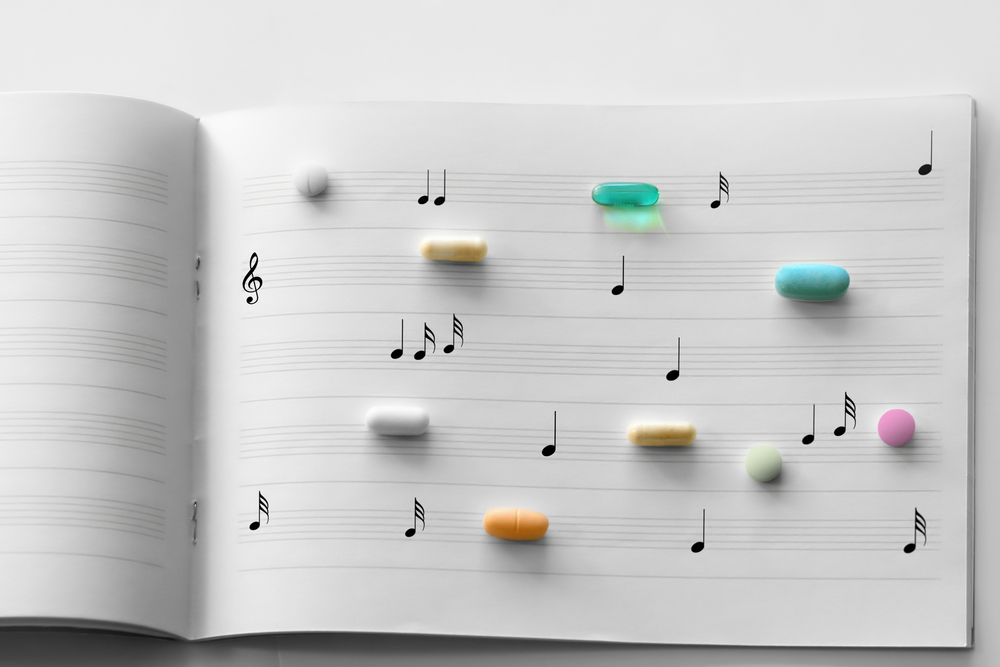Have you ever felt your mood lift after listening to an upbeat song? Or have you noticed how listening to calming music can relax your mind and body? While music’s positive effects on our emotions are well known, its benefits extend far beyond our feelings.
Scientists say music and medicine have intriguing links. Music reduces pain, anxiety, stress, blood pressure, and heart rate. It may also improve immunity and speed healing.
As a natural tool without side effects, music complements clinical care for many conditions. Its potential as a healing method fascinates both those experiencing illness and researchers. Music’s impact on well-being piques our curiosity about its role in health and treatment.

The Historical Harmony Between Music and Healing
The historical blend of music and medicine established therapeutic music’s roots. Ancient Greece acknowledged the links between mental and physical health through healing sounds. Indigenous peoples likewise embraced music’s capacity to boost wellness.
One of the earliest known mentions of music therapy appeared in a 1789 document. During the early 1800s, physicians began validating music’s application in healthcare through dissertations and studies. They proposed and confirmed music interventions helped both children and adults.
In 1914, surgeons even noticed enhanced postoperative outcomes when coupling procedures with tunes, backing music’s medical integration. These pioneering approaches set the foundation for today’s music therapy field. They demonstrated music’s ability to aid recovery processes and improve patient experiences.
Evidence continually accumulated from antiquity through the early 1900s, reinforcing sound’s potential for therapeutic application and complementing conventional care.
Decoding How Music Influences the Brain?
Here are some points you need to know:
Dopamine Release
Listening to enjoyable music directly stimulates the brain regions involved in reward processing and pleasure, triggering dopamine releases in the nucleus accumbens. This natural high encourages repetition and positive emotional associations with music.
Reduced Stress Hormones
Soothing musical tones engage the parasympathetic nervous system, lowering heart rate, blood pressure, and levels of stress hormones like cortisol and adrenaline circulating throughout the body. This helps counterbalance the adverse physiological effects induced by stressful situations.
Synchronized Brain Waves
When we tap, dance, or immerse ourselves in a rhythmic musical beat, distinct brain areas synchronize theta wave activity to communicate with each other optimally. This coordination between regions involved in movement, cognition, and emotion enhances processing and integration across functional systems.
Spatial Reasoning Boost
Long-term studies consistently show children who receive years of active musical training through playing an instrument exhibit stronger structural connectivity in the brain between auditory and spatial processing areas. This may transfer to improved performance on skills requiring visual-spatial abilities and sequential reasoning.
Memory Formation
The limbic system, which regulates emotion and memory, strongly associates particular songs with personal experiences, effectively making music emotionally charged memory cues. Recalling a melody can reactivate neural patterns from the accompanying life event.
Movement Facilitation
Specific motor planning and control centers in the cerebellum and basal ganglia subtly anticipate and synchronize with musical rhythms. This enables entertainment and adaptation of physical motions like dancing, foot-tapping, or fine motor finger movements almost effortlessly along the beat.
The Psychological Impact of Musical Interventions
Background music services play a crucial role in psychological wellness. Studies show that their ambient, calming selections lower customers’ stress, anxiety, and depression.
These melodic backgrounds naturally lift moods, whether passively enjoyed at stores, workplaces, or hospitals. Actively creating music through singing or instruments also boosts self-esteem and fulfillment for some undergoing therapy. Background tunes facilitate bonding and pleasure, too. By engaging our reward pathways through enjoyment, these background music service provider may indirectly support cognition and quality of life. Their role in mental health shows music’s profound psychological impacts, even from ambient sounds.
Music in Surgical Settings: A Tool for Healing
Hospital background music has emerged as an impactful tool for facilitating healing in surgical settings.
Studies show that patients who listened to calming melodies during medical procedures often required less anesthesia and reported reduced anxiety, pain, and need for painkillers post-operation.
Not only does soothing hospital background music distract the mind from discomfort, but it may also positively influence stress hormone levels in the body. Forward-thinking hospitals are now implementing music therapy programs, piping relaxing tunes throughout operating rooms and recovery areas. The calming hospital background music has psychological and physiological effects that complement medical interventions.
Music’s Effect on Physical Rehabilitation
Music can meaningfully support the physical recovery process. For rehabilitation patients, engaging with enjoyable tunes reduces fatigue and makes exercises feel less arduous.
Soothing melodies may distract the mind from soreness while lowering stress hormones that hamper healing. During sessions, motivating music paired with movement helps patients safely push their physical limits.
Over time, these benefits can translate to improved mobility, strength, and overall wellness. Progressive facilities now incorporate tunes and rhythms into therapy to lift the spirit and encourage patients as their bodies mend. The power of music to heal spans the mind and muscles.
Frequently Asked Questions
How does music reduce pain and anxiety?
Studies show music may stimulate the brain to release endorphins and change thought patterns linked to pain perception and stress responses.
What medical conditions does music therapy help?
Conditions like Alzheimer’s, cancer, heart disease, and pre/post-surgery recovery have all shown improvements with music interventions.
Is music therapy an effective treatment?
Research increasingly demonstrates music’s ability to aid clinical treatment and complement conventional care across numerous applications.
What kinds of music are most therapeutic?
Different genres may target specific needs, but calming styles like classical, nature sounds, and some pop/folk have relaxing effects for most wellness applications.
Conclusion
In conclusion, the historical relationship between music and healing established music therapy as a recognized discipline.
Early civilizations intuitively grasped music’s impact on well-being. Through successive validation over centuries, it became clear that sounds have tangible health effects.
Today, numerous medical applications exist thanks to those who explored music’s benefits. Continued research will only deepen our understanding of the profound yet scientifically sound links between music and the mind-body connection in sickness and health.